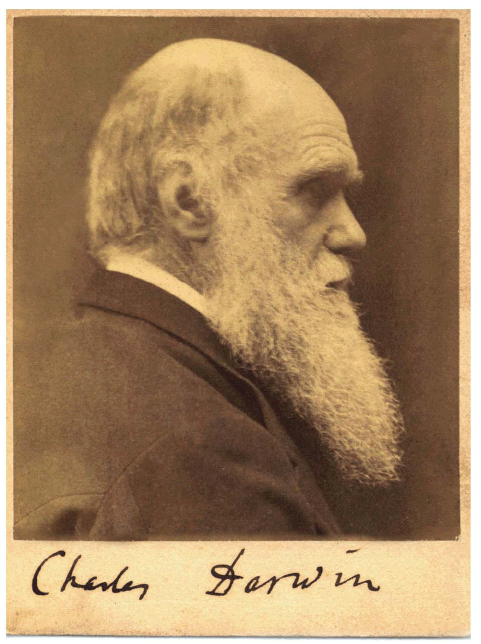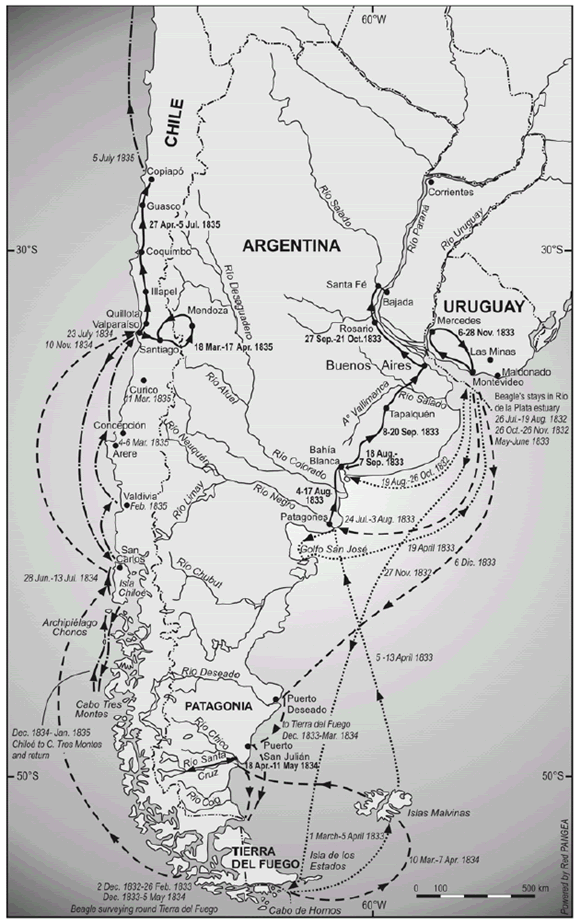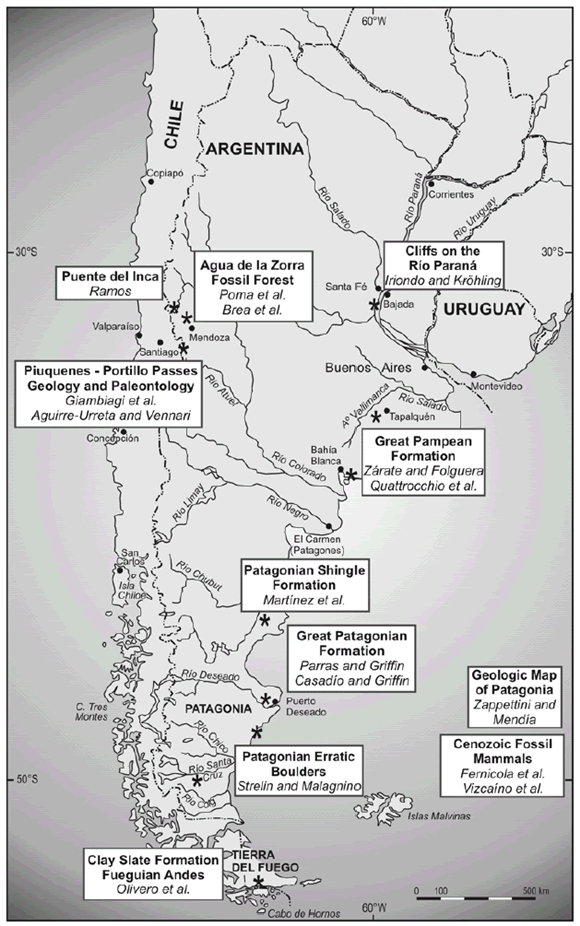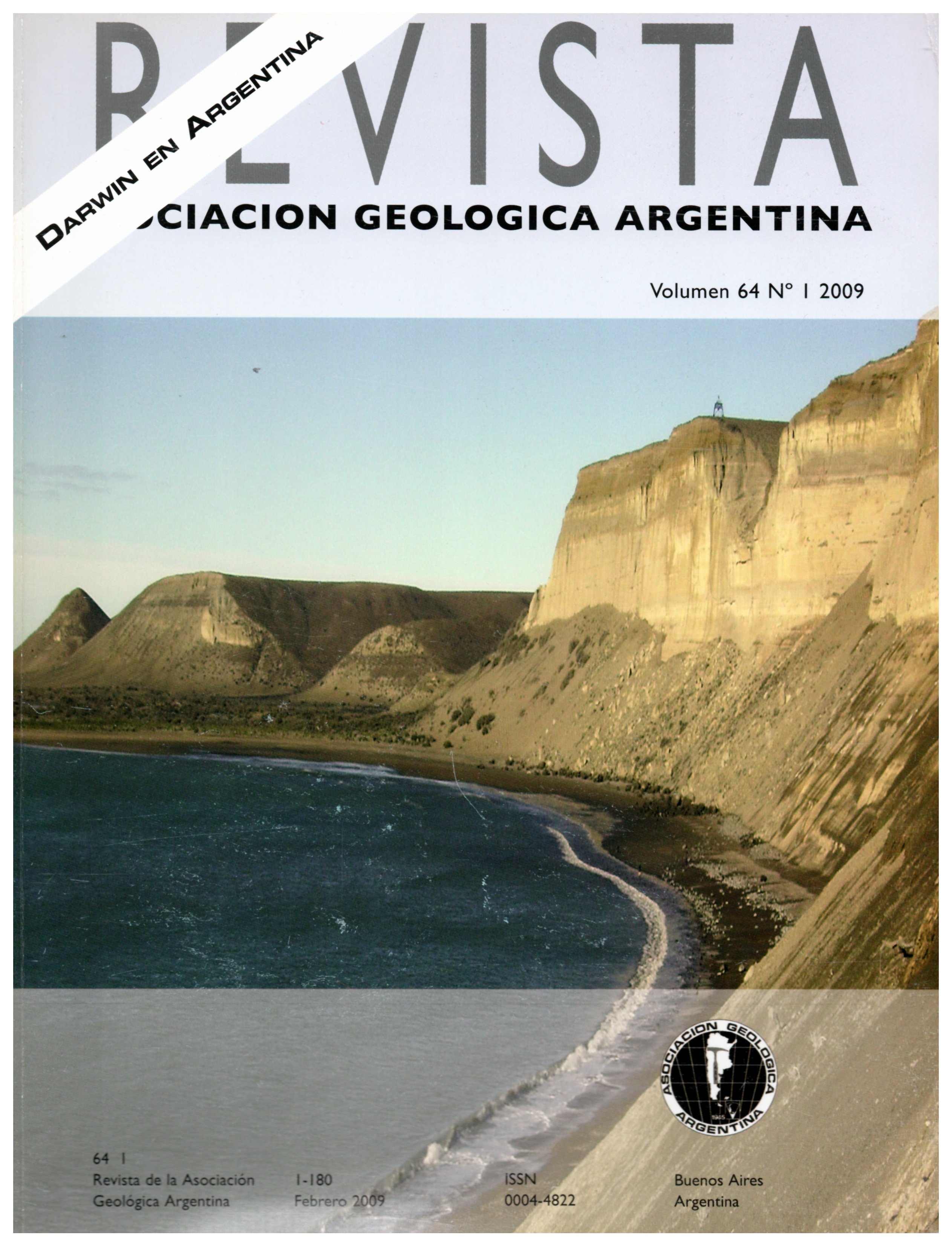Darwin's geological research in Argentina
Main Article Content
Abstract

Portrait with signature gifted by Charles Darwin to the Academia Nacional de Ciencias in 1878 acknowledging his nomination as an Honorary
Member. Photograph taken by Julia Margaret Cameron in 1868. Unpublished original copy kept in the Academia (see Depetris this volume)
On the occasion of the 200th. anniversary of Charles Darwin´s birth, the Asociación Geológica Argentina decided to prepare a special issue devoted to the geological research undertaken by Darwin in Argentina. As it is well known, during his journeys on board HMS Beagle under the command of Captain Robert FitzRoy, he had the opportunity to survey overland different areas of South America. Darwin spent nearly three years - between August 1832 and April 1835 - visiting and studying different regions of our country, as illustrated in figure 1.

Figure 1: Journeys of HMS Beagle in southern South America (base map modified from Bowly 1990). Dates of Darwin's rides overland are shown in bold while the trips on board HMS Beagle are shown in italics, taken from Keynes (2001).
The aim of this special issue is to analyze his important geological observations and to emphasize the validity of many of his ideas under a 21st Century perspective. In order to accomplish this aim, several key localities that Darwin examined from a geological point of view during his voyage were selected. Such an analysis was carried out by several geologists and paleontologists well acquainted with the diverse problems that Darwin faced along his journeys in Argentina.
HMS Beagle's main mission was to survey the coasts of southern South America, which it carried out during several journeys along the coast. The time needed to chart the coast in details gave Darwin several opportunities to spend considerable time on land. During the survey he also had many occasions to land at selected points along the Atlantic coast.
The first of these fieldtrips was done between August and October 1832 and gave him the opportunity to visit Punta Alta near the fort of Bahía Blanca (Fig. 1). The second one was between November 1832 and May 1833 to visit the Beagle Channel, the surrounding areas of Tierra del Fuego Island, and the Malvinas Islands.
The third and more important fieldtrip was, after landing in Carmen de Patagones in August 1833 (Fig. 1), to ride across the Pampas to Buenos Aires city and later on to Santa Fé and Bajada (today Paraná city) on the Río Paraná. The fourth trip began in Montevideo in December 1833 and allowed Darwin to examine various points along the Patagonian coast such as Puerto Deseado and Puerto San Julián. Afterwards HMS Beagle sailed to Tierra del Fuego where it spent nearly four months until March 1834. Later on it visited again different areas of the Malvinas Islands. In April of 1834 it anchored in the mouth of Río Santa Cruz. It was during this trip that Darwin, FitzRoy and more than 20 crew members sailed upstream the Río Santa Cruz in three small whale boats, almost reaching its headwaters near the foothills of the Patagonian Andes.
This fourth trip continued across the Magallanes and strait of along the Pacific coast landing in Valparaíso in July 1834, and spending several months surveying the Chilean coast. Darwin's last visit to Argentina was between March and April 1835 (Fig. 1), when he crossed the Andes between Santiago and Mendoza following two different cordilleran passes. The different contributions of this issue were organized based on stratigraphic record and location (Fig. 2). The sections of the Andes are the first to be analyzed, then Patagonia and Tierra del Fuego, and finally the Cenozoic of the Pampas, ending with the origin of Puente del Inca and Darwin's tectonic ideas on the formation of the Andes.

Figure 2: Approximate location of the different contributions dealing with Darwin's geological research in Argentina indicated by an asterisk (compare with Figure 1).
Pedro J. Depetris describes the documents kept in the Academia Nacional de Ciencias in Córdoba related to the nomination of Darwin, first as corresponding member and then as honorary member of the Academy. This paper also presents Darwin's original letter where he acknowledges the nomination and the front page of the book on the Origin of the Species that Darwin dedicated to the academy.
Stella Poma, Vanesa D. Litvak, Magdalena Koukharsky, Beatriz Maisonnave and Sonia Quenardelle describe the rocks in which the Triassic forest at Agua de la Zorra is included as being part of a pyroclastic flow. Their petrographic studies confirm the previous description of Darwin on the presence of fine volcanic material. Based on their observations, they answer Darwin's queries about the process that buried the forest in standing position. It should be noted that these pyroclastic flows were unknown at the time of Darwin's visit.
Mariana Brea, Analía E. Artabe and Luis A. Spalletti deal with the first in situ forest discovered in South America by Darwin in his trip across the Andes. This forest was described in detail by Darwin as monotypic and assigned to the Tertiary. Their study reveals that the paleovegetation of Agua de La Zorra forest is composed by conifers and corystosperms reaching up to 20-26 meters high forming a two-storeyed arboreal strata and an understorey of ferns. It was reassigned to the Triassic and reconstructions of the forest landscape are presented.
Beatriz Aguirre-Urreta and Verónica Vennari study a small collection of fossil invertebrates from the Piuquenes Pass, a locality discovered by Darwin during his crossing of the High Andes from Santiago to Mendoza. They compared this collection with the fossils that allowed Darwin to propose a Neocomian age for the bearing strata. This assignation is confirmed and the time span stretched to the Tithonian based on key ammonites of that age.
Laura Giambiagi, Maisa Tunik, Victor A. Ramos and Estanislao Godoy compare the observations of Darwin on the structure of the High Andes between the Piuquenes and Portillo passes with modern structural knowledge. They remark the awareness of Darwin on the episodic uplift of the Andes with the rise of the Principal Cordillera first and a later uplift of the Frontal Cordillera, both in post- Cretaceous times.
Eduardo Zappettini and José Mendía introduce the first geological map of Patagonia ever compiled, publishing the first color hand-drafted copy. It was drawn by Darwin after his trip to South America. These authors outline the main geological units used in the map and validate them with the present knowledge of the geology of the region.
Eduardo B. Olivero, Francisco A. Medina and María I. López C. analyze the still unsolved problem of Darwin's "Clay Slate Formation" in the Fueguian Andes. This term coined for the Cretaceous successions, presently includes a series of marine mudstones the stratigraphy of which is based on scarce fossils, mainly inoceramids and ammonites. The present use of trace fossils and distinctive ichnofabrics, together with new ammonites, are contributing to a better understanding of these mudstones, improving stratigraphic correlation among different units.
Ana Parras and Miguel Griffin present the sedimentology and fossil contents of a classic Miocene locality, first described by Darwin at the southern bank of Río Santa Cruz, along the Patagonian coast. This is the type locality of most of the fossils found in his "Great Patagonian Tertiary Formation" and later described by Sowerby (1846). The rocks of this section are presently included in the Monte León Formation.
The contribution by Silvio Casadio and Miguel Griffin deals with the sedimentology and paleontology of a classic locality at Puerto Deseado (Port Desire). This locality was visited by Darwin in 1833 when he collected fossil mollusks, and remained nearly unexplored by geologists and paleontologists ever since. The authors assess this classic Miocene locality and correlate it with several similar sequences exposed along the Atlantic cliffs.
Oscar A. Martínez, Jorge Rabassa and Andrea Coronato discuss one of the most intriguing lithostratigraphic units in the Late Cenozoic of Patagonia named by Darwin the "Patagonian Shingle Formation". They analyze the prevailing paradigm of that time that assigned these rocks to the "Great Universal Dèlluge" and give a modern perspective to the origin of the "Rodados Patagónicos".
Jorge Strelin and Eduardo Malagnino analyze the observations of Darwin in his trip upstream the Río Santa Cruz in 1834. Special emphasis is paid to the extension of the big erratic boulders and gravels described by Darwin which are now interpreted as indicators of a maximum glacial expansion in Patagonia. Those blocks together with some new findings are ascribed by these authors to a catastrophic event related to the outburst of a large lake.
Martín Iriondo and Daniela Kröhling cover the visit of Darwin to Santa Fé with special emphasis in those localities described by him along the Río Paraná banks. The authors stress the precise descriptions of Darwin and discuss the Late Cenozoic age of these sediments.
Marcelo Zárate and Alicia Folguera deal with the geologic characteristics of the Pampas south of Río Salado, a region that impressed Darwin on his ride from Bahía Blanca to Buenos Aires. They discuss the Pampean Formation of Darwin, its present stratigraphic divisions, its age, and the different environments encompassed in this unit, from a modern perspective.
Mirta E. Quattrocchio, Cecilia M. Deschamps, Carlos A. Zavala, Silvia C. Grill and Ana M. Borromei give an updated vision of the scenery described by Darwin when he visited Bahía Blanca and surrounding areas. Multidisciplinary results were integrated by these authors in a chronosequence chart. This diagram shows the suggested space-time correlation of the recognized events in the Late Miocene-Holocene history of the southwestern Pampas.
Juan Carlos Fernicola, Sergio F. Vizcaíno and Gerardo De Iuliis provide a synthesis of the present knowledge of the large fossil mammals collected by Darwin, mostly from the Pampean region of central Argentina. These authors ponder on the reasons that led Darwin to recognize only megatheres and mastodonts for the large fossil remains and discuss the current taxonomic status of the taxa described or erected by Owen between 1837 and 1845.
Sergio F. Vizcaíno, Richard A. Fariña and Juan Carlos Fernicola, in their contribution on the Pleistocene South American mammals, attempt to provide answers to Darwin's questions, such as what has exterminated so many living creatures? Their study on the palaeobiology of these organisms shed light on the understanding of their evolution intermingled with ecology and phylogeny.
Victor A. Ramos searches on the origin of Puente del Inca, a natural bridge described by Darwin in the High Andes, during his cross by the Uspallata o La Cumbre Pass. Applying uniformitarism, the author interprets the origin of Puente del Inca as initially formed as an ice bridge, latter on cemented by hot spring waters. Ramos also weighs Darwin's thoughts on mountain uplift based on the Mesozoic successions of the Puente del Inca section. His old ideas on tectonics anticipate in many decades some concepts of the geosynclinal theory and also on the present fold and thrust belt mechanics.
We would wish to acknowledge the reviewers of the present issue: S. Bargo (Universidad Nacional de La Plata), M. Bond (Universidad Nacional de La Plata), N. Carmona (CADIC, Ushuaia), C. Costa (Universidad Nacional de San Luis), R. Charrier (Universidad de Chile), J.S. Crampton (Institute of Geological and Nuclear Sciences, New Zealand), A. Crame (British Antarctic Survey, UK), D. Croft (Case Western Reserve University, USA), I.W.D. Dalziel (University of Texas, USA), R. De Barrio (INREMI, La Plata), E. Derbyshire (University of London, UK), C. Deschamps (Universidad Nacional de La Plata), E. Godoy (Santiago de Chile), P. Imbellone (Universidad Nacional de La Plata), C. Janis (Brown University, USA), M. Kaplan (Columbia University, USA), S.M. Kay (Cornell University, USA), H.A. Leanza (MACN, Buenos Aires), E. Llambías (CIG, La Plata), T. Manera (Universidad Nacional del Sur, Bahía Blanca), S. Martinez (Universidad de la República, Uruguay), G. McDonald (National Park Service, USA), A. Mourgues (SERNAGEOMIN, Chile), C.A. Mpodozis (Antofagasta Minerals, Chile), D. Muhs (United States Geological Survey, USA), S. Nielsen (Christian-Albrechts-Universität, Germany), O. Orfeo (Centro de Ecología Aplicada del Litoral, Corrientes), E.G. Ottone (Universidad de Buenos Aires), J. Panza (SEGEMAR, Buenos Aires), R.N. Page (SEGEMAR, Buenos Aires), G. Pastorino (MACN, Buenos Aires), G.J. Retallack (University of Oregon, USA), P. Sruoga (SEGEMAR, Buenos Aires), J. Stilwell (Monash University, Australia), M. Suarez (SERNAGEOMIN, Chile), M. Toledo (Muséum National d'Histoire Naturelle, France) and G. Vucetich (Universidad Nacional de La Plata).
WORKS CITED IN THE TEXT
1. Bowly, J. 1990. Charles Darwin, a new biography. Hutchinson Press, 511 p., London, Sydney, Auckland and Johannesburg. [ Links ]
2. Keynes, R.D. 2001. Charles Darwin's Beagle Diary. Cambridge Univesity Press. 464 p., Cambridge. [ Links ]
3. Sowerby, G.B. II 1846. Descriptions of the Tertiary fossil shells from South America. In Darwin, C. Geological observations on South America. Being the third part of the geology of the voyage of the Beagle, under the command of Capt. Fitzroy, R.N. during the years 1832 to 1836. Smith Elder and Co. Ed., Appendix: 249-264, London. [ Links ]
Article Details

This work is licensed under a Creative Commons Attribution-NonCommercial 4.0 International License.
Nota de copyright
Los autores conservan los derechos de autor y garantizan a la revista el derecho de ser la primera publicación del trabajo licenciado según una licencia de atribución Creative Commons que permite a otros compartir el trabajo con el reconocimiento de la autoría y de la publicación en la que se publicó por primera vez.
Declaración de privacidad
Los nombres y direcciones de correo electrónico introducidos en esta revista se usarán exclusivamente para los fines declarados por esta revista y no estarán disponibles para ningún otro propósito u otra persona.

